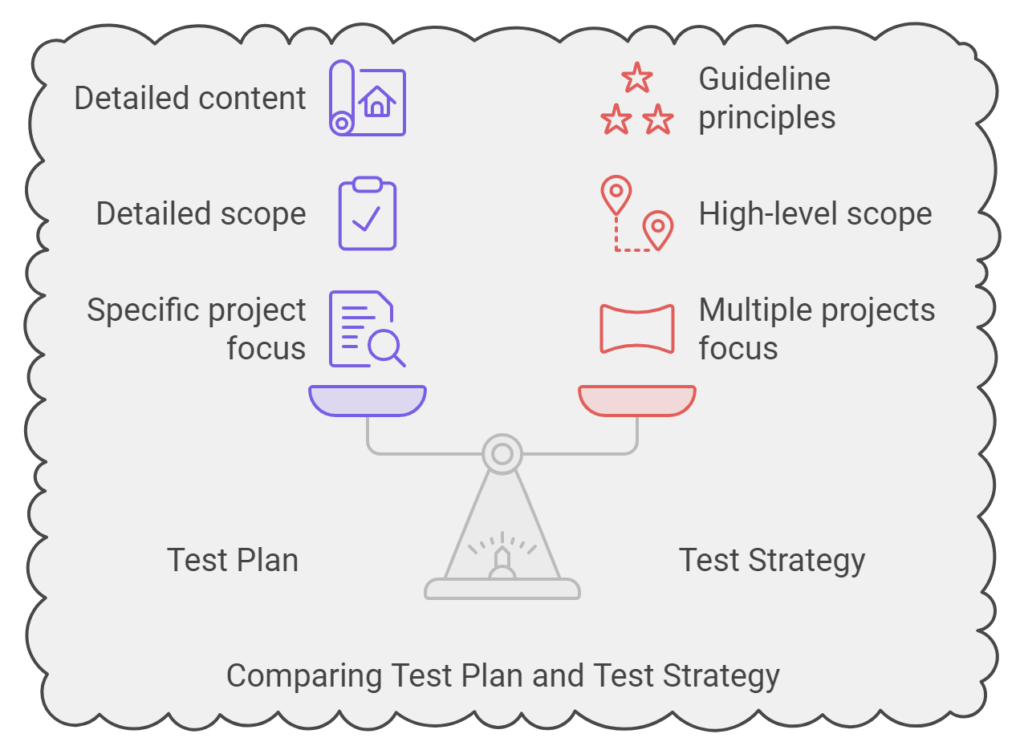Test Plan and Test Strategy are both crucial documents in software testing, but they serve different purposes and contain distinct information. Here’s a comparison between the two:

Test Plan:
1. Purpose:
- The test plan outlines the approach for testing a specific project or release.
2. Scope:
- It defines the detailed scope of testing, specifying what will and won’t be tested.
- It includes information about the features, modules, or components to be tested.
3. Content:
- It contains detailed information about the test cases, test scenarios, and test data.
- It provides a step-by-step execution plan for testing activities.
- It includes details on entry and exit criteria for each testing phase.
4. Timeframe:
- The test plan often includes a detailed timeline, milestones, and deadlines for testing activities.
5. Resource Allocation:
- It specifies the roles and responsibilities of the testing team and other stakeholders.
- It outlines the allocation of resources, such as testing tools and environments.
6. Risk Assessment:
- It may briefly mention risks but doesn’t go into detail.
- It doesn’t typically include comprehensive risk mitigation strategies.
7. Reporting:
- It may include reporting mechanisms for test progress and results.
8. Audience:
- The primary audience for the test plan is the testing team and project stakeholders.
9. Level of Detail:
- It provides a more detailed and granular view of the testing activities and execution.
10. Living Document: – It is often updated and modified as the project progresses and as testing requirements change.
Test Strategy:
1. Purpose:
- The test strategy outlines the high-level approach and goals for testing across multiple projects or releases.
2. Scope:
- It focuses on the overall testing approach and principles, not on specific features or modules.
3. Content:
- It doesn’t contain detailed test cases or execution plans; instead, it provides guidelines and principles for testing.
4. Timeframe:
- It doesn’t typically include specific timelines or milestones.
5. Resource Allocation:
- It defines the roles and responsibilities of the testing team in a general sense.
6. Risk Assessment:
- It includes a broader discussion of potential risks and high-level strategies for risk mitigation.
7. Reporting:
- It usually doesn’t include specific reporting mechanisms or templates.
8. Audience:
- The primary audience for the test strategy is senior management and stakeholders involved in multiple projects.
9. Level of Detail:
- It provides a high-level overview and approach to testing activities.
10. Living Document: – It is less likely to change frequently and serves as a guiding document for multiple projects.
In summary, while the test plan focuses on the specific details and execution of testing activities for a particular project, the test strategy provides a high-level framework and guidelines for testing across multiple projects or releases. Both documents are essential for effective testing, but they serve different purposes and address different levels of detail.
Here’s a comparison of Test Plan and Test Strategy in tabular form:
| Aspect | Test Plan | Test Strategy |
|---|---|---|
| Purpose | Outlines the approach for testing a specific project or release. | Outlines the high-level approach and goals for testing across multiple projects or releases. |
| Scope | Defines the detailed scope of testing, specifying what will and won’t be tested. Includes information about the features, modules, or components to be tested. | Focuses on the overall testing approach and principles, not on specific features or modules. |
| Content | Contains detailed information about the test cases, test scenarios, and test data. Provides a step-by-step execution plan for testing activities. Includes details on entry and exit criteria for each testing phase. | Doesn’t contain detailed test cases or execution plans; provides guidelines and principles for testing. |
| Timeframe | Often includes a detailed timeline, milestones, and deadlines for testing activities. | Doesn’t typically include specific timelines or milestones. |
| Resource Allocation | Specifies the roles and responsibilities of the testing team and other stakeholders. Outlines the allocation of resources, such as testing tools and environments. | Defines the roles and responsibilities of the testing team in a general sense. |
| Risk Assessment | May briefly mention risks but doesn’t go into detail. Doesn’t typically include comprehensive risk mitigation strategies. | Includes a broader discussion of potential risks and high-level strategies for risk mitigation. |
| Reporting | May include reporting mechanisms for test progress and results. | Usually doesn’t include specific reporting mechanisms or templates. |
| Audience | The primary audience is the testing team and project stakeholders. | The primary audience is senior management and stakeholders involved in multiple projects. |
| Level of Detail | Provides a more detailed and granular view of the testing activities and execution. | Provides a high-level overview and approach to testing activities. |
| Living Document | Often updated and modified as the project progresses and as testing requirements change. | Less likely to change frequently; serves as a guiding document for multiple projects. |
This table summarizes the key differences between a Test Plan and a Test Strategy, highlighting their distinct purposes and content.
Please let us know if your comments/updates for this article by posting in comment section!!
Happy Learning!
Team doWhileLearn